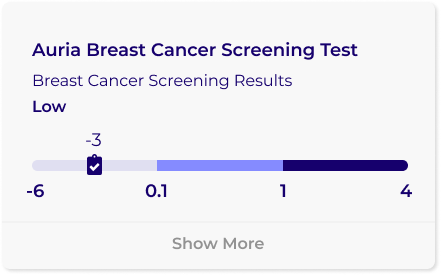Introducing Auria At-Home Breast Screening
The Auria at-home breast cancer screening test empowers you to take control of your health. By providing a simple and convenient test that can be done from the comfort of your own home, Auria offers a truly innovative solution to detecting potential signs of breast cancer, with the power of tears.

Why tears?
Protein biomarkers found in tears
Auria analyzes the protein biomarkers found in your tears. Unlike DNA, proteins undergo changes in response to different molecular events that occur in the body. These proteins are significant in the initial stages of inflammation and may increase due to irregularities in your breast tissue.
Breast abnormalities could be caused by various factors and can take different forms, like fibrocystic changes, early tumor formation, cysts, and calcifications. The Auria test can indicate changes in protein biomarkers, which means further assessment of your breast tissue may be necessary. While the test does not confirm the presence of breast cancer, like a mammogram, it can provide valuable information for further evaluation.


Backed by research
Tears, the transparent liquid produced by our eyes, have the potential to offer significant insights into our health. This often-overlooked fluid could prove invaluable in the early detection of diseases like breast cancer.
Tear composition includes proteins, lipids, small molecules, and even genetic material, that might serve as indicators of underlying health conditions. The process of collecting tear samples is simple, painless, and doesn’t require invasive procedures.
This approach stands in contrast to blood collection, which can be more invasive. Researchers are actively comparing the content of tears to that of blood to establish tears as a promising source of biomarkers, potentially revolutionizing disease detection and diagnosis.
What We Found
Tears could be the key to detecting diseases quickly and conveniently. Scientists are exploring the potential of using tears for biomarker research, which could revolutionize the way we detect diseases. The next step is to study patients with specific diseases to understand the potential of tear biomarkers for diagnosis. Exciting times lie ahead, and who knows, maybe one day we’ll be able to detect diseases just by shedding a tear!
Trust and Accuracy
The Auria test has been developed using a wealth of scientific research. It’s important to note that while this test shows promise, it’s not a definitive diagnosis. However, it can serve as a valuable first step in identifying potential risks. The sensitivity and specificity of the test – its ability to correctly identify those with and without breast cancer – have been carefully evaluated and refined through extensive studies.
Empowering Early Detection
The power of the Auria test lies in its ability to provide early indications of potential breast health concerns. By using tears as a non-invasive and accessible source of information, this test aims to empower individuals to take charge of their health and engage in proactive conversations with healthcare professionals.

A step forward in health care
The Auria at-home breast screening test is a significant milestone in the healthcare industry. It is a revolutionary innovation that utilizes tears to extract valuable information for the early detection of breast health issues. While no screening test is perfect, Auria represents a significant step toward making breast health monitoring proactive, easy, and accessible. It empowers individuals to take charge of their health by providing them with vital information to prioritize their well-being with confidence.
Next steps
If the Auria test suggests a potential concern, following up with your healthcare provider is essential. They can recommend further examinations or screenings to confirm the results. Remember, the Auria test complements existing screening methods and enhances your breast health journey.

Frequently Asked Questions
Auria’s proprietary algorithm uses the concentrations of S100A8 and S100A9 determined from the tear sample, together with age, to produce the score.
Namida Lab (developer of Auria®) has 3 ongoing clinical trials. The following are Namida’s current clinical trial numbers: NCT05268224-DB; NCT05223218; NCT04928014
Genetic screening is used to identify mutations in the BRCA1 and BRCA2 genes and can be a great tool, particularly for women with a family history of breast cancer. However, genetic screening is expensive and these genes only account for 15-20% of all breast cancers. 89% of breast cancer occurs in women with no family history.
Auria is a lab-developed test (LDT) that has been validated in Namida Lab’s high-complexity Clinical Laboratory Improvement Amendments (CLIA) lab under the supervision of our Medical Director. An LDT is a test that is designed, developed, and performed within a single laboratory, regulated by the Centers for Medicare & Medicaid Services (CMS), through the Clinical Laboratory Improvement Amendments (CLIA). Currently, the FDA exercises enforcement discretion over LDTs. Certification of the laboratory is required under CLIA to ensure the validity and quality of the test.
Unfortunately, we have not been able to conduct a study looking at our markers for reoccurrence in breast cancer so without that data is difficult to say for sure. While we did have triple negative cases in our breast cancer clinical data set we used for validating the test in our CLIA lab that were all accurately classified, the overall number was quite small and they were newly diagnosed cases not under treatment. It’s very likely long-term treatment for metastatic breast cancer could impact the expression of our markers.
Yes, your kit does expire. Your kit will have a minimum expiration date of 6 months. The expiration date can be found on the label on the bottom of your Auria box. Any samples that are delivered to the lab after the expiration date will not be processed, and we are unable to provide a replacement kit.
The breast health consultation provided with every test kit regardless of risk score, is with a breast health expert that is either a Nurse Practitioner or Registered Nurse.
Your Auria consultation is an engaging, informative session with one of our Breast Health Specialists. They provide insights based on your unique health history, answer questions, and guide you toward optimal breast health outcomes. You will gain early access to expert insights that are usually offered post-diagnosis. Your consultation is personalized and focused on your unique needs. All consultations are included with the Auria test kit.
Once your results are ready, you’ll be able to schedule a consultation with our Breast Health Specialists (BHS) through an email link or through your dashboard. At your scheduled appointment time, you will meet with a BHS via a Zoom link that is emailed to you. During the consultation, the BHS will review your results and the information you provided in your breast health survey and will guide you through potential next steps. You will understand the impact of modifiable risk factors on your breast health, and you will have an open session time for you to ask any lingering questions you may have.
Your test results will provide you with a score and classification of low, medium, or high. A medium or high classification does not mean you have breast cancer, but rather the score produced from your sample could be elevated due to a breast abnormality.
Auria determines the concentration of two proteins from your tear sample. These two proteins are part of the early inflammatory process and could be elevated due to malignancy but can also be elevated due to benign masses. These concentrations are used, together with age, in our proprietary algorithm to calculate your AURIA SCORE.
The AURIA SCALE was developed using the scores from over 1000 clinical samples. The classifications of low, medium, and high were developed based on retrospective clinical analysis of follow-up imaging. Early data suggests scores in the medium or high category are associated with increased molecular events in the host tissue and should be evaluated by follow-up imaging in a timely manner.
